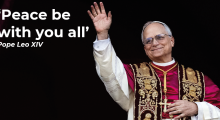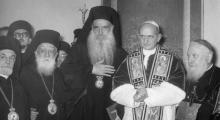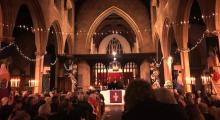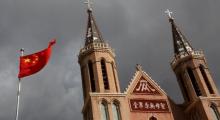Issued by the Catholic Center for Studies and Media - Jordan. Editor-in-chief Fr. Rif'at Bader - موقع أبونا abouna.org

Cyprus has close historical, cultural and religious ties with Greece that go back to ancient times. Along with ethnicity, Greek Cypriots and Greeks share a common heritage, language and religion, though over the centuries Cyprus has had more contacts with the Middle East, due to its geographical position and to the presence of significant ethnic minorities from this area. Indeed, Cyprus is considered to be a bridge between the East and the West.
An ancient Church
Christianity in the two countries traces its roots back to the Apostolic Era, namely to the Apostle Paul who preached in Greece, but also evangelized Cyprus together with the Apostle Barnabas, who is considered to be the founder of the Cypriot Church. Moreover, both countries are of Orthodox tradition, with the Orthodox making up an overwhelming majority, though the Autocephalus Church of Cyprus does not enjoy the privileged legal status of the Greek one.
The Latin-rite Church
Cypriot Catholics presently make up 4.75% of the population (38,000) and are for the most part of Latin rite. Many of them trace their roots back to Crusaders who settled there in the late 12th century, following the Third Crusade (1191) and the fall of Jerusalem to Saladin (1187).
The Latin Catholics thrived until Cyprus was conquered by the Turks in 1570-1573, when thousands were killed, churches converted to mosques, and the Latin Church dissolved. However, they survived the Ottoman rule in great part thanks to the Franciscan Order, which has been present in the island since its founding in the 13th century and still plays a central role in the local Church today.
The policy of tolerance under the subsequent British rule (1878-1960) strengthened the Latin community allowing its full integration in Cypriot society. The process of emancipation has further advanced since independence in 1960, when the new Constitution officially recognized the Catholic Church and, at a political level, reserved a seat in Parliament to each one of the three Catholic communities present on the island.
Despite the 1974 Turkish invasion, which forced many Catholic families to flee from the North, the Latin Catholic community in Cyprus has continued to thrive, contributing actively to the development of the country, particularly in the field of education. The Latin community is also very active in the social field, through charitable organizations helping the poor and most vulnerable, refugees and foreign workers.
The Cypriot Latin Church is under the Jurisdiction of the Latin Patriarchate of Jerusalem and is entrusted to a Latin Patriarchal Vicar, presently Father Jerzy Kraj, OFM. The Patriarchate manages the Saint-Paul parish of Paphos, while the remaining three parishes are administered by the Franciscan Order.
Maronite Catholics
The second largest Catholic community in Cyprus are the Maronites, who presently make up 1.5% of the population. Maronites arrived in successive waves starting from the 8th century and thrived under the Latin rule, becoming the largest Eastern Christian community after the local Greek one. Numbers dropped dramatically following the Ottoman take over in the 16th century and subsequent persecutions. They started to grow again under the British rule and after independence, with many Lebanese arriving after war broke out in Lebanon in 1975.
Following the partition of Cyprus in 1974, however, the number of Maronites has thinned down drastically in the North. Overall, Maronite Catholics amounted to some 13,000 in 2019. They are for the most part concentrated in Nicosia and under the jurisdiction of the Archeparchy of Cyprus, currently governed by Archbishop Selim Jean Sfeir.
In terms of cultural distinctiveness, the Maronites of Cyprus are predominately native Greek speakers. Presently, however, they also speak different languages, as they have throughout their history, which include Syriac, Arabic, French and Italian.
Armenian Catholics
The smallest Cypriot Catholic community is the Catholic-Armenian one. Its presence dates back to the 6th century when Armenian war prisoners were transfered on the island. More Christian Armenians, mainly belonging to the Armenian Orthodox Apostolic Church, came over in the following centuries, especially in the 13th century.
Catholic Armenians also benefitted from British rule. More Armenians arrived in Cyprus during the massacres by the Turks in World War I, the partition of Palestine in 1948, and the war in Lebanon (1975-1990). Some 3,000-4,000 live in Cyprus today, for the most part in the capital, Nicosia.
Good ecumenical relations
The major Christian Churches in Cyprus, also including Protestants and Anglicans, work closely together and enjoy good ecumenical relations. Over the past 15 years, the Holy See and the majority Orthodox Church have strengthened their fraternal relations, which have been actively supported by His Beatitude Chrysostom II, Archbishop of New Giustiniana and All Cyprus.
On 16 June 2007, the Orthodox Primate signed a Joint Declaration with Benedict XVI on the occasion of his visit to the Vatican. Pope Benedict XVI subsequently met Archbishop Chrysostom II on two further occasions: on 5 June 2010, during his Apostolic Journey to Cyprus, when he gave the Orthodox Primate a copy of the Instrumentum laboris (working document) of the Special Synod of Bishops for the Middle East held in October that year and on 28 March 2011, again in the Vatican.







